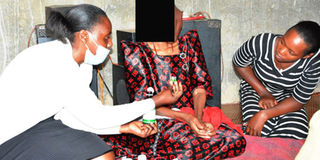‘Tumours shouldn’t be taken lightly’

Kitovu Mobile palliative care nurses give a dosge of oral morphine that Joan (not real names) needs to taae in four hour interval. Photo | Wilson Kutamba
What you need to know:
- A biopsy is the removal of cells or tissues for examination by a pathologist. The pathologist then tests samples of the patient to establish whether he or she has cancer or any other disease based on the laboratory analysis of either blood urine or body tissues.
“I thought it was a mere swelling that could go away on its own. But it persisted, gradually swelling more and more. I did not know what caused it until June when doctors told me it is cancer,” Jane (not real name) narrates the story behind the swelling on her left cheek to Kitovu Mobile Palliative care nurses.
They had paid her a visit at her daughter’s home in Seke, Lwengo District to give her pain-relieving drugs and counselling.
In a low tone, the 60-year-old says: “I regret taking long to confirm if the swelling was indeed a simple one with no medical threats as I had been assured by a village herbalist.”
About three years ago, Ms Betty Onzia felt a lump in her right breast but could not get a firm grip of it, so she ignored it. The 61-year-old farmer and resident of Arua is now battling breast cancer.
“At first I felt a little pain just at the nipple where I felt the lump but the pain disappeared and the lump did not increase in size,” Ms Onzia told Daily Monitor.
“I would also feel cold in the breast but there was no need for me to worry or even seek medical attention since there was no pain. I thought it was a mere swelling that could go away on its own,” she adds.
Also known as body swelling, a tumour, as defined by the National Cancer Institute, is “an abnormal mass of tissue that results when cells divide more than they should or do not die when they should.” They can vary in size from a tiny nodule to a large mass, depending on the type, and they can appear almost anywhere on the body.
While some tumours are benign, that is, they consist of noncancerous cells, others can be cancerous (malignant) as Dr Ritah Nabulya, the manager of Kitovu Mobile medical services, explains.
Benign tumours do not possess the ability to metastasize and can be removed surgically. On the other hand, malignant ones can spread from one organ to another hence require early diagnosis and treatment because they are life-threatening.
“This is why it is of great importance for anyone with a swelling to seek medical attention to know if the swelling is benign or metastatic; but not simply taking it as a simple one as late confirmation may come with bitter effects,” Nabulya warns.
She explains that biopsy of the swelling is taken and sent for pathology to help ascertain the type of the swelling and determine treatment.
A biopsy is the removal of cells or tissues for examination by a pathologist. The pathologist then tests samples of the patient to establish whether he or she has cancer or any other disease based on the laboratory analysis of either blood urine or body tissues.
The pathologist may study the issue under a microscope or perform other tests on the cells or tissues.
Ms Nabulya says there are many people who have an illusion that biopsies as well as surgery aggravate cancer hence they turn down the procedures. She, however, emphasizes that these are effective diagnostic tools for detection of cancer.
“Avoiding biopsies may lead to late detection and poor prognosis of the disease,” she says.
She adds that many people attribute cancer to supernatural factors, ill fate and witchcraft hence spending a lot of money seeking for cure from supernatural healing, herbal medicine and witchcraft.
“These delay early diagnosis and treatment of the cancers hence the patient ends up seeking medical care when the cancer has already spread,” Ms Nabulya says.





